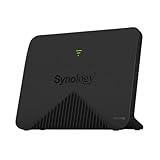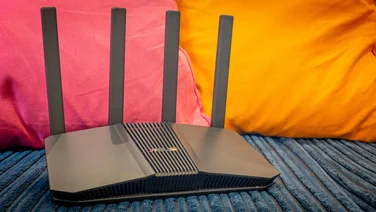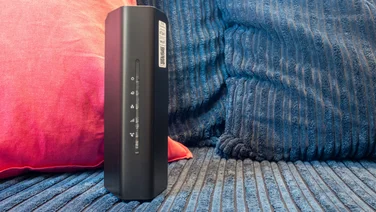To help us provide you with free impartial advice, we may earn a commission if you buy through links on our site. Learn more










- Superb web interface
- Loaded with advanced router features
- Mediocre performance, even in mesh mode
- Expensive if you want multiple units
We’ve seen plenty of mesh Wi-Fi systems that come with two or three nodes in the box, but the MR2200ac is something a bit different. It comes as a fully featured standalone router, which you can turn into the hub of a mesh system by simply buying additional units and configuring them as connected Wi-Fi Points.
It’s a clever approach – but is it smart and cost-effective enough to compete with existing routers and complete mesh kits?
READ NEXT: Best mesh Wi-Fi systems
Synology MR2200ac review: What you need to know










The MR2200ac is a tri-band 802.11ac Wave 2 router. Its twin 5GHz radios are rated at 867Mbits/sec apiece, while the 2.4GHz band has a maximum data rate of 400Mbits/sec.
Interestingly, the MR2200ac is the first router we’ve seen to support WPA3, the incoming security standard which makes future wireless devices even harder to spy on than the current generation. There are also extensive parental controls, and safe search enforcement to keep users away from dangerous sites. A small app store lets you install a few optional features, such as a VPN server and a media streaming service.
Plus, of course, there’s the handy ability to install additional MR2200ac units and connect them together to form a mesh network, extending your wireless network over a wider area.
Synology MR2200ac review: Price and competition










The MR2200ac costs £132: that’s not exactly pocket money, but it’s a good price for a router with this breadth of features. If you’re looking for a cheaper option, D-Link’s Exo AC2600 can now be had online for just £80, and has the same total bandwidth over 5GHz. It lacks the advanced security features of the MR2200ac, though, and since it only features dual-band radios, in practice it’s likely to be a bit slower due to increased contention.
Alternatively, you could step up to TP-Link’s Archer VR2800; that costs around £50 more than the MR2200ac, but it has faster wireless hardware, claiming a total throughput of 2167Mbits/sec on the 5GHz band and 600Mbits/sec at 2.4GHz.
If you want to take advantage of the MR2200ac’s mesh capabilities, you’ll need to buy a second unit, and that pushes the price up to £264. That’s more expensive than Zyxel’s mighty Multy X mesh kit, and a lot more than BT’s Whole Home Wi-Fi system, which costs just £182 for a three-node pack.
The trade-off is that these products don’t have the extensive range of network features and controls of the MR2200ac. Indeed, the BT discs merely work as simple extenders for your existing router. As we’ll discuss below, however, dedicated mesh systems do have the advantage when it comes to performance.
Synology MR2200ac review: Features










Almost all routers have a web-based management portal – but not all such portals are created equal. The MR2200ac’s rich, mouse-driven SRM interface is probably the best we’ve seen. it’s very similar to the DSM firmware found on Synology’s NAS appliances, and frankly it feels more like using a Linux desktop than configuring a router, with all features accessible via intuitive icons and menus. This makes it a positive joy to explore what the router has to offer, and for those who prefer to control things from the palm of their hand, there’s also an app for Android and iOS.
Whichever interface you choose, there are plenty of options and features to play with. You can set up a secondary guest network with its own schedule and greeting portal, connect to an impressive range of dynamic DNS providers and even enable a built-in VPN server, so you can easily and safely access your home network from anywhere in the world.
You can also engage Synology’s security and parental control features. This enables you to apply time limits, safe search settings for Bing, Google and YouTube, and category-based web filtering, all on a per-user or per-group basis. What’s more, you can get notifications of various sorts of event via email, SMS or push notification via the smartphone app. The built-in security advisor checks your system and any connected storage for malware while auditing your router and network settings for any security holes. As we’ve mentioned, there’s support for WPA3 too, but there’s literally nothing to see here – it’s just a smarter, more secure way for compatible Wi-Fi devices to connect.
The last few tricks are enabled via the USB 3 socket at the router’s rear. Plug in a mobile broadband dongle and you can set up 3G and 4G failover, allowing you to keep on surfing even if your regular connection goes down. Or, you can connect an external storage device and turn the MR2200ac into a simple Synology NAS server, complete with user account management, cloud access and DLNA media streaming capabilities.
READ NEXT: Our Google WiFi review
In short, the MR2200ac has a feature set to compete with routers costing twice as much – and it’s definitely more versatile than any dedicated mesh system we’ve tested. If all that potential leaves you feeling overwhelmed, it even has a built-in live help system.
There are just two things to be aware of. First, as is common with standalone routers, there’s no built-in modem; you’ll either need a separate box to handle your DSL, cable or fibre connection or to keep your existing router and use the MR2200ac solely as an access point. Do this and you’ll still get the benefit of WPA3, but parental controls and other advanced features are disabled.
Second, around the back, there’s just a single Gigabit Ethernet port. This is, in my view, a bafflingly bad design decision. I get that this is a router designed for the wireless age, but there are plenty of things in the modern home – from smart-home hubs to NAS drives, consoles and video streaming boxes – that either require or work best with a wired connection. You can use an Ethernet switch to wire up multiple devices to the one port, but that’s fiddly, and it’s yet another box to clutter up the place.
Synology MR2200ac review: Performance










The MR2200ac is quite a compact little thing, its front face measuring just 154 mm x 199 mm. And inside it has an internal 2×2 MIMO antenna array, rather than the 3×3 or 4×4 arrangements found in some more sizeable routers. For those reasons, I wasn’t expecting it to break records for performance.
To test this, I installed the MR2200ac in the awkward corner of my home where the fibre cable comes in, then carted my 802.11ac-equipped Surface Laptop around to various rooms in the house in turn, and measured file copy speeds to and from a local NAS appliance.
|
Upload (MB/sec) |
Download (MB/sec) |
|
|
Hallway |
7 |
10.7 |
|
Bedroom |
3.1 |
5.7 |
|
Utility room |
2.4 |
11.9 |
|
Bathroom |
2.3 |
7 |
As you can see from the graph above, the MR2200ac delivered pretty good download rates in every room. To be sure, there are faster routers out there: the £219 Linksys EA9500 was up to twice as fast, delivering download speeds of 28MB/sec at short range and keeping up 13MB/sec in the bathroom at the far end of the building. Overall though performance was solid and consistent.
However, while my laptop received a good signal from the router, the reverse wasn’t always true. As I moved away from the MR2200ac, upload speeds plummeted. You might think that’s not a huge issue, as most of us download far more than we upload, but those low speeds in the bathroom and utility room reflect a flaky, intermittent connection that’s susceptible to hiccups and glitches. If you’ve ever had to click repeatedly on a web link to get the page to load, you’ll know what I’m talking about.
Still, nil desperandum. The whole point of the MR2200ac is that you can add on a second unit to get a stronger signal in more remote places. And since this is a tri-band system, one 5GHz radio is used for backhaul traffic between the two nodes, while client devices connect to the other, so you don’t get the halving of bandwidth that affects simple Wi-Fi extenders.
Setting up mesh mode is almost embarrassingly easy: you simply plug in your second router in a room near to the original one, then log into SRM and select “add Wi-Fi point”. After a few minutes of updating, your second unit is up and rebroadcasting the wireless network – and you can check your network topology and monitor activity via a handy live view in the web interface.
Adding the second node certainly made a difference in spots which had suffered from patchy coverage: though upload speeds weren’t exactly lightning fast, there was now no noticeable stalling:
|
Upload (MB/sec) |
Download (MB/sec) |
|
|
Hallway |
10.6 |
14.1 |
|
Bedroom |
3.2 |
14.9 |
|
Utility room |
0.7 |
10.7 |
|
Bathroom |
1.3 |
8.7 |
At the same time, you’ll notice that download speeds actually fell in most locations – and I can tell you why. Synology warns you not to put your second node too far away from the first, so for testing I put it just one room away, in the kitchen. I literally could not have put it nearer without having both nodes absurdly in the same room. Even so, SRM reported that the connection between the two nodes was only “Fair”. As a result, even when my laptop had a strong and fast connection to the secondary node, the connection from there to the primary node – and hence to the internet and other local devices – wasn’t as fast as it might have been.
Indeed, the speeds I saw lagged a long way behind other mesh systems I’ve tested. With a pair of Zyxel Multy X units in the same locations, for example, I got download speeds of 15.9MB/sec in the bedroom, and 17MB/sec in the bathroom. Upload speeds were much more consistent too, never dipping below 8MB/sec. Perhaps if you have paper-thin walls or live in an area with little interference you’ll get faster speeds than I did from the Synology, but my tests strongly suggest you’ll be better off with a different mesh product.
READ NEXT: Our Synology RT1900ac review
Synology MR2200ac review: Verdict
The MR2200ac makes a superb first impression. The firmware is supremely slick and friendly, almost every technical box is ticked, and the security and parental control features are very reassuring.
Unfortunately, I found performance was mediocre and unbalanced in standalone mode – and if you shell out for a second unit, that pushes the price up beyond many better-performing mesh kits. Even though the MR2200ac is one of the friendliest and most versatile routers I’ve tried, most people will be better off with either a regular router or a dedicated mesh system.
| Synology MR2200ac specifications | |
|---|---|
| Processor | Quad-core 717MHz |
| Memory | 256MB DDR3 |
| Ports | 1 x LAN, 1 x WAN, 1 x USB, 1 x 240V AC |
| Frequencies | 2.4GHz, 5GHz-1, 5GHz-2 |
| Size (WDH) | 199 x 65 x 154mm |
| Weight | 0.45kg |








